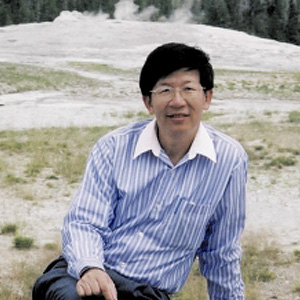 |
姓名 |
楊鴻昌
Hong-Chang Yang |
| 職稱 |
教授 |
| 學歷 |
1983年愛荷華州立大學物理博士 |
| 辦公室 |
|
| 聯絡電話 |
|
| 電子郵件 |
|
| 個人網頁 |
|
| 教學與研究領域 |
研究專長領域為超導量子干涉元件(SQUID)物理與磁學應用; 薄膜與光電元件物理; 光激發原子磁量計物理與應用; 光激發氦三稀有氣體物理與生醫應用; 奈米磁性粒子與檢測應用; SQUID磁共振造影與檢測應用; 心磁波圖像、腦磁圖影像測量與數據處理; 心臟生理學; 人腦科學研究。教學科目:高等實驗物理、固態物理, 基礎實驗物理等。
研究專長包括:
1. 量子元件物理與磁性檢測應用:
高敏感度之SQUID磁量計及梯度計等之量子物理與其在生物訊號研究。
2.低磁場磁共振造影術之研發及應用研究;
以SQUID偵測器來研發低磁場磁共振造影術, 生物標地物及腫瘤檢應用。
3. 高敏感度原子磁量計之研發;
以雷射極化Rb金屬藉由共振吸收特性來創新高敏感度之原子磁量計物理與應用研究。
4. 奈米磁性粒子, 磁性測量技術與免疫研究;
利用披覆生物探針的磁性奈米粒子與磁性測量來檢測標地物的新穎研究。
5. 生物磁場訊號之檢測研究:
將敏感之磁場感測器應用於心磁波圖像、腦磁圖影像研究。 |
| 代表著作 |
- H.H. Chen, Hong-Chan Yang, H.E. Horng, Y.Y. Lee, S.H. Liao, S.Y. Yang, C.H. Chou, L.J. Chang, M.J. Chen, M.Y. Chern, Phys. Rev. A 81, 033422-1-033422-6 (2010).
- Hong-Chang Yang*, Herng-Er Horng, S. Y. Yang and Shu-Hsien Liao, “Advances in biomagnetic research using high-Tc superconducting quantum interference devices”, Supercon. Sci. Technol. Supercond. Sci. Technol. 22, 093001 (2009) (Topical review).
- C.C. Wu , L. Y. Lin , H.C. Huang , Y.B. Liu , M.F. Chen , P.S. Tsai , Y.L. Gao , Shieh-Yueh Yang , Hong-Chang Yang*, W.K. Tseng , T.L. Lee , C.F. Hsuan , Y.H. Lee, “Two-dimensional propagations of magnetocardiac T-wave signals for characterizing the cardiac abnormalities”, Appl. Phys. Lett., 92, 194104-1-194104-3 (2008).
- Hong-Chang Yang*, J. C. Chen, C.H. Wu+, and K. L. Chen, Herng-Er Horng, Yi-Shou Tsai and S. Y. Yang, “The balance and noise properties of directly coupled high-Tc superconducting quantum interference device gradiometers with a serial array”, Appl. Phys. Lett., 92, 033501 (2008).
- Hong-Chang Yang*, Ji-Chen Chen, Chiu-Hsien Wu, and Kuen-Lin Chen, Herng-Er Horng and S.Y. Yang, “High-Tc superconducting quantum interference devices: status and perspectives”, 104, 011101-1-011101-3, (2008). (Selected as the cover image of the Journal)
- C.C. Wu, B.F. Hong, B.H. Wu, S.Y. Yang, and H.E. Horng+,*, H.C. Yang*, W.Y. Tseng, W.K. Tseng, Y.B. Liu, L.C. Lin, and L.S. Lu, and Y.H. Lee, “Animal’s magnetocardiography using superconductive quantum interference device gradiometers assisted with magnetic nanoparticle injection - A sensitive method for early detecting electromagnetic changes induced by hypercholesterolemia”, Appl. Phys. Lett., 90, 054111 (2007).
- Hong-Chang Yang*, Shu-Hsien Liao, Herng-Er Horng*, Shing-Ling Kuo, Hsin-Hsien Chen, and S. Y. Yang, “Enhancement of High-Tc SQUID-detected NMR signals with pre-polarization of magnetization in microtesla magnetic field”, Appl. Phys. Lett. 88, 252505-1-252505-3 (2006).
- C.-Y. Hong, C.C. Wu, Y.C. Chiu, S.Y. Yang, H.E. Horng, and H.C. Yang*, “Magnetic Susceptibility Reduction Method for Magnetically Labeled Immunoassay”, Appl. Phys. Lett. 99, 212512-1-1212512-3 (2006).
- C. H. Wu, U.C. Sou, J. C Chen, K. L. Chen and H. C. Yang*, M. H. Hsu and T. S Lai, J. T. Jeng, Y. S. Tsai and H. E. Horng, “Influence of bicrystal microstructural defects on high-transition-temperature direct-current superconducting quantum interference device”, Appl. Phys. Lett. 88, 102504-1-102504-3 (2006).Labeled Immunoassay”, Appl. Phys. Lett. 99, 212512-1-1212512-3 (2006).
|